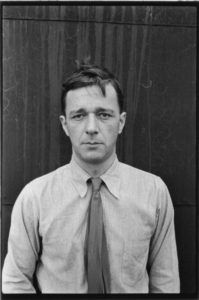Walker Evans (November 3, 1903 – April 10, 1975) was an American photographer and photojournalist best known for his work for the Farm Security Administration (FSA) documenting the effects of the Great Depression. His work captures the dark landscape of the American South—its overgrown yards, decaying mansions, paint-peeled front porches and quiet corner stores that bear the traces of the region’s historical scars. “I can understand why Southerners are haunted by their own landscape”, he once stated. His work is a prime example of Gothic Americana photography.
 Many of his works are in the permanent collections of museums and have been the subject of retrospectives at such institutions as the Metropolitan Museum of Art or George Eastman Museum.
Many of his works are in the permanent collections of museums and have been the subject of retrospectives at such institutions as the Metropolitan Museum of Art or George Eastman Museum.
In the summer of 1936, while on leave from the FSA, he and writer James Agee were sent by Fortune magazine on assignment to Hale County, Alabama, for a story the magazine subsequently opted not to run. In 1941, Evans’s photographs and Agee’s text detailing the duo’s stay with three white tenant families in southern

Alabama during the Great Depression were published as the groundbreaking book Let Us Now Praise Famous Men. Its detailed account of three farming families paints a deeply moving portrait of rural poverty.
Evans died at his apartment in New Haven, Connecticut, in 1975. The last person Evans talked to was Hank O’Neal. In reference to the newly created A Vision Shared project, O’Neal recounts that “The picture on the back of the book, of him taking a picture – he actually called me up and told me he had found it”. “And then the next morning I got up and I had a phone call from Leslie Katz, who ran the Eakins Press. And Leslie said: ‘Isn’t it terrible about Walker Evans?’ And I said: ‘What are you talking about?’ He said: ‘He died last night.’ I said: ‘Cut it out. I talked to him last night twice’ … So an hour and a half after we had our conversation, he died. He had a stroke and died.”





